Extracting Disaster-Related Location Information through Social Media to Assist Remote Sensing for Disaster Analysis: The Case of the Flood Disaster in the Yangtze River Basin in China in 2020
Abstract
1. Introduction
1.1. Rapid Extraction of Disaster-Related Location Information Contained in Social Media Data
1.2. Flood Disaster Assessment and Monitoring Combined with Multi-Source Data
2. Study Area and Data
2.1. Study Area
2.2. Data Collection
2.2.1. Remote Sensing Data
2.2.2. Social Media Data
3. Methods
3.1. Location Information Extraction Based on Social Media Text
3.1.1. Text Processing
3.1.2. Part of Speech Selection and Word Set Construction
3.1.3. Recalling the Locational Words
- (1)
- The construction of candidate locational word set
- Spatial attribute judgment based on Baidu Encyclopedia
- Spatial attribute judgment based on Baidu Map
- (2)
- Recall of locational words
3.2. The Social Network Construction Based on Location Information
- : social media data themselves contained a location tag, but its text did not contain locational words.
- : social media data themselves did not contain a location tag, but its text contained locational words.
- : social media data themselves contained a location tag, and its text also contained locational words.
3.3. Flooded Area Extraction Based on Multi-Temporal Remote Sensing Images
3.4. Comprehensive Analysis
3.4.1. Disaster Assessment Combined with Multi-Source Data
3.4.2. Continuous Monitoring of Disaster in Flooded Areas Combined with Social Media Data
4. Results
4.1. Locational Words Extraction
4.2. Disaster Analysis Combined with Multi-Source Information
4.2.1. Disaster Assessment Combined with Multi-Source Data
4.2.2. Continuous Monitoring of Disaster in Flooded Areas Combined with Social Media Data
5. Conclusions
Author Contributions
Funding
Institutional Review Board Statement
Informed Consent Statement
Data Availability Statement
Conflicts of Interest
References
- Ntontis, E.; Drury, J.; Amlôt, R.; Rubin, G.J.; Williams, R. Endurance or decline of emergent groups following a flood disaster: Implications for community resilience. Int. J. Disaster Risk Reduct. 2020, 45, 101493. [Google Scholar] [CrossRef]
- Swain, D.L.; Wing, O.E.; Bates, P.D.; Done, J.M.; Johnson, K.A.; Cameron, D.R. Increased flood exposure due to climate change and population growth in the United States. Earth’s Future 2020, 8, e2020EF001778. [Google Scholar] [CrossRef]
- Špitalar, M.; Brilly, M.; Kos, D.; Žiberna, A. Analysis of flood fatalities–Slovenian illustration. Water 2020, 12, 64. [Google Scholar] [CrossRef]
- Schumann, G.J.; Brakenridge, G.R.; Kettner, A.J.; Kashif, R.; Niebuhr, E. Assisting flood disaster response with earth observation data and products: A critical assessment. Remote Sens. 2018, 10, 1230. [Google Scholar] [CrossRef]
- Wang, X.; Xie, S.; Zhang, X.; Chen, C.; Guo, H.; Du, J.; Duan, Z. A robust Multi-Band Water Index (MBWI) for automated extrac-tion of surface water from Landsat 8 OLI imagery. Int. J. Appl. Earth Obs. Geoinf. 2018, 68, 73–91. [Google Scholar] [CrossRef]
- Zhang, T.; Ren, H.; Qin, Q.; Zhang, C.; Sun, Y. Surface water extraction from Landsat 8 OLI imagery using the LBV transfor-mation. IEEE J. Sel. Top. Appl. Earth Obs. Remote Sens. 2017, 10, 4417–4429. [Google Scholar] [CrossRef]
- Rosser, J.F.; Leibovici, D.; Jackson, M. Rapid flood inundation mapping using social media, remote sensing and topographic data. Nat. Hazards 2017, 87, 103–120. [Google Scholar] [CrossRef]
- Kawamura, Y.; Dewan, A.M.; Veenendaal, B.; Hayashi, M.; Shibuya, T.; Kitahara, I.; Nobuhara, H.; Ishii, K. Using GIS to develop a mobile communications network for disaster-damaged areas. Int. J. Digit. Earth 2014, 7, 279–293. [Google Scholar] [CrossRef]
- Wang, Z.; Ye, X. Social media analytics for natural disaster management. Int. J. Geogr. Inf. Sci. 2018, 32, 49–72. [Google Scholar] [CrossRef]
- Li, J.; He, Z.; Plaza, J.; Li, S.; Chen, J.; Wu, H.; Wang, Y.; Liu, Y. Social media: New perspectives to improve remote sensing for emergency response. Proc. IEEE 2017, 105, 1900–1912. [Google Scholar] [CrossRef]
- Denis, L.A.S.; Palen, L.; Anderson, K.M. Mastering social media: An analysis of Jefferson County’s communications during the 2013 Colorado floods. In Proceedings of the 11th International ISCRAM Conference, University Park, PA, USA, 1 May 2014. [Google Scholar]
- Huang, Q.; Cervone, G.; Zhang, G. A cloud-enabled automatic disaster analysis system of multi-sourced data streams: An example synthesizing social media, remote sensing and Wikipedia data. Comput. Environ. Urban Syst. 2017, 66, 23–37. [Google Scholar] [CrossRef]
- Li, J.; Benediktsson, J.A.; Zhang, B.; Yang, T.; Plaza, A. Spatial technology and social media in remote sensing: A survey. Proc. IEEE 2017, 105, 1855–1864. [Google Scholar] [CrossRef]
- Scotti, V.; Giannini, M.; Cioffi, F. Enhanced flood mapping using synthetic aperture radar (SAR) images, hydraulic model-ling, and social media: A case study of Hurricane Harvey (Houston, TX). J. Flood Risk Manag. 2020, 13, 12647. [Google Scholar] [CrossRef]
- Fohringer, J.; Dransch, D.; Kreibich, H.; Schröter, K. Social media as an information source for rapid flood inundation mapping. Nat. Hazards Earth Syst. Sci. 2015, 15, 2725–2738. [Google Scholar] [CrossRef]
- Li, Z.; Wang, C.; Emrich, C.T.; Guo, D. A novel approach to leveraging social media for rapid flood mapping: A case study of the 2015 South Carolina floods. Cartogr. Geogr. Inf. Sci. 2018, 45, 97–110. [Google Scholar] [CrossRef]
- Huang, X.; Wang, C.; Li, Z. A near real-time flood-mapping approach by integrating social media and post-event satellite imagery. Ann. GIS 2018, 24, 113–123. [Google Scholar] [CrossRef]
- Ahmad, K.; Pogorelov, K.; Riegler, M.; Ostroukhova, O. Automatic detection of passable roads after floods in remote sensed and social media data. Signal Process. Image Commun. 2019, 74, 110–118. [Google Scholar] [CrossRef]
- Cervone, G.; Schnebele, E.; Waters, N.; Moccaldi, M. Using social media and satellite data for damage assessment in urban areas during emergencies. In Seeing Cities through Big Data; Springer: Berlin/Heidelberg, Germany, 2017; pp. 443–457. [Google Scholar]
- Chong, W.-H.; Lim, E.-P. Exploiting contextual information for fine-grained tweet geolocation. In Proceedings of the International AAAI Conference on Web and Social Media, Montreal, QC, Canada, 15–18 May 2017. [Google Scholar]
- Mahmud, J.; Nichols, J.; Drews, C. Where is this tweet from? inferring home locations of twitter users. In Proceedings of the Sixth International AAAI Conference on Weblogs and Social Media, Dublin, Ireland, 4–7 June 2012. [Google Scholar]
- Cheng, Z.; Caverlee, J.; Lee, K. You are where you tweet: A content-based approach to geo-locating twitter users. In Proceedings of the 19th ACM International Conference on Information and Knowledge Management, Toronto, ON, Canada, 26–30 October 2010. [Google Scholar]
- Middleton, S.E.; Middleton, L.; Modafferi, S. Real-time crisis mapping of natural disasters using social media. IEEE Intell. Syst. 2013, 29, 9–17. [Google Scholar] [CrossRef]
- Maynard-Ford, M.C.; Phillips, E.C.; Chirico, P.G. Mapping Vulnerability to Disasters in Latin America and the Caribbean, 1900–2007; Open-File Report 2008-1294; US Geological Survey: Reston, VA, USA, 2008; p. 30.
- Milanova, I.; Silc, J.; Serucnik, M.; Eftimov, T.; Gjoreski, H. LOCALE: A Rule-based Location Named-entity Recognition Method for Latin Text. In Proceedings of the HistoInformatics@ TPDL Conference, Oslo, Norway, 12 September 2019; pp. 13–20. [Google Scholar]
- Sugiartaa, N.P.A.S.A.; Sanjaya ER, N.A. Location Named-Entity Recognition using Rule-Based Approach for Balinese Texts. J. Elektron. Ilmu Komput. Udayana 2021, 9, 15. [Google Scholar]
- Shue, L.; Dey, S.; Anderson, B. On state-estimation of a two-state hidden Markov model with quantization. IEEE Trans. Signal Process. 2001, 49, 202–208. [Google Scholar] [CrossRef][Green Version]
- Lafferty, J.; McCallum, A.; Pereira, F.C. Conditional random fields: Probabilistic models for segmenting and labeling sequence data. In Proceedings of the 18th International Conference on Machine Learning 2001, Online. 28 June 2001. [Google Scholar]
- Shao, X.; Kim, C.S. Multi-step short-term power consumption forecasting using multi-channel LSTM with time location con-sidering customer behavior. IEEE Access 2020, 8, 125263–125273. [Google Scholar] [CrossRef]
- Hong, S.; Jang, H.; Kim, N.; Sohn, H.G. Water area extraction using RADARSAT SAR imagery combined with landsat imagery and terrain information. Sensors 2015, 15, 6652–6667. [Google Scholar] [CrossRef] [PubMed]
- Baike. Available online: https://baike.baidu.com/ (accessed on 15 January 2022).
- Zhang, L.; Wang, S.; Liu, H.; Lin, Y.; Wang, J.; Zhu, M.; Gao, L.; Tong, Q. From Spectrum to Spectrotemporal: Research on Time Series Change Detection of Remote Sensing. Geomat. Inf. Sci. Wuhan Univ. 2021, 46, 451–468. [Google Scholar] [CrossRef]
- Howarth, P.J.; Wickware, G.M. Procedures for change detection using Landsat digital data. Int. J. Remote Sens. 1981, 2, 277–291. [Google Scholar] [CrossRef]
- Chapman, B.; McDonald, K.; Shimada, M.; Rosenqvist, A. Mapping regional inundation with spaceborne L-band SAR. Remote Sens. 2015, 7, 5440–5470. [Google Scholar] [CrossRef]
- Martinis, S.; Twele, A.; Voigt, S. Unsupervised extraction of flood-induced backscatter changes in SAR data using Markov image modeling on irregular graphs. IEEE Trans. Geosci. Remote Sens. 2010, 49, 251–263. [Google Scholar] [CrossRef]
- Bartsch, A.; Trofaier, A.; Hayman, G.; Sabel, D. Detection of open water dynamics with ENVISAT ASAR in support of land surface modelling at high latitudes. Biogeosciences 2012, 9, 703–714. [Google Scholar] [CrossRef]
- Evans, T.L.; Costa, M.; Telmer, K. Using ALOS/PALSAR and RADARSAT-2 to map land cover and seasonal inundation in the Brazilian Pantanal. IEEE J. Sel. Top. Appl. Earth Obs. Remote Sens. 2010, 3, 560–575. [Google Scholar] [CrossRef]
- Simon, R.; Tormos, T.; Danis, P. Geographic object based image analysis using very high spatial and temporal resolution radar and optical imagery in tracking water level fluctuations in a freshwater reservoir. South-East. Eur. J. Earth Obs. Geomat. 2014, 3, 287–291. [Google Scholar]
- Dewan, A.M.; Kankam-Yeboah, K. Using synthetic aperture radar (SAR) data for mapping river water flooding in an urban landscape: A case study of Greater Dhaka, Bangladesh. J. Jpn. Soc. Hydrol. Water Resour. 2006, 19, 44–54. [Google Scholar] [CrossRef]
- Otsu, N. A threshold selection method from gray-level histograms. IEEE Trans. Syst. Man Cybern. 1979, 9, 62–66. [Google Scholar] [CrossRef]
- Rajaraman, A.; Ullman, J.D. Mining of Massive Datasets; Cambridge University Press: Cambridge, UK, 2011. [Google Scholar]
- Tausczik, Y.R.; Pennebaker, J.W. The psychological meaning of words: LIWC and computerized text analysis methods. J. Lang. Soc. Psychol. 2010, 29, 24–54. [Google Scholar] [CrossRef]
- Yang, T.; Xie, J.; Li, G.; Mou, N.; Li, Z. Social media big data mining and spatio-temporal analysis on public emotions for dis-aster mitigation. ISPRS Int. J. Geo-Inf. 2019, 8, 29. [Google Scholar] [CrossRef]
- Oh, O.; Kwon, K.H.; Rao, H.R. An Exploration of Social Media in Extreme Events: Rumor Theory and Twitter during the Haiti Earthquake 2010. In Proceedings of the International Conference on Information Systems, ICIS 2010, Saint Louis, MI, USA, 12–15 December 2010; Volume 231, pp. 7332–7336. [Google Scholar]
- Fang, J.; Hu, J.; Shi, X.; Zhao, L. Assessing disaster impacts and response using social media data in China: A case study of 2016 Wuhan rainstorm. Int. J. Disaster Risk Reduct. 2019, 34, 275–282. [Google Scholar] [CrossRef]
- Yang, T.; Xie, J.; Li, G.; Mou, N.; Chen, C.; Zhao, J.; Liu, Z.; Lin, Z. Traffic Impact Area Detection and Spatiotemporal Influence Assessment for Disaster Reduction Based on Social Media: A Case Study of the 2018 Beijing Rainstorm. ISPRS Int. J. Geo-Inf. 2020, 9, 136. [Google Scholar] [CrossRef]
- Klemas, V. Remote sensing of floods and flood-prone areas: An overview. J. Coast. Res. 2015, 31, 1005–1013. [Google Scholar] [CrossRef]
- Lin, L.; Di, L.; Yu, E.G.; Kang, L.; Shrestha, R.; Rahman, M.S.; Tang, J.; Deng, M.; Sun, Z.; Zhang, C.; et al. A review of remote sensing in flood assessment. In Proceedings of the 2016 Fifth International Conference on Agro-Geoinformatics, Tianjin, China, 18–20 July 2016; IEEE: New York, NY, USA, 2016. [Google Scholar]
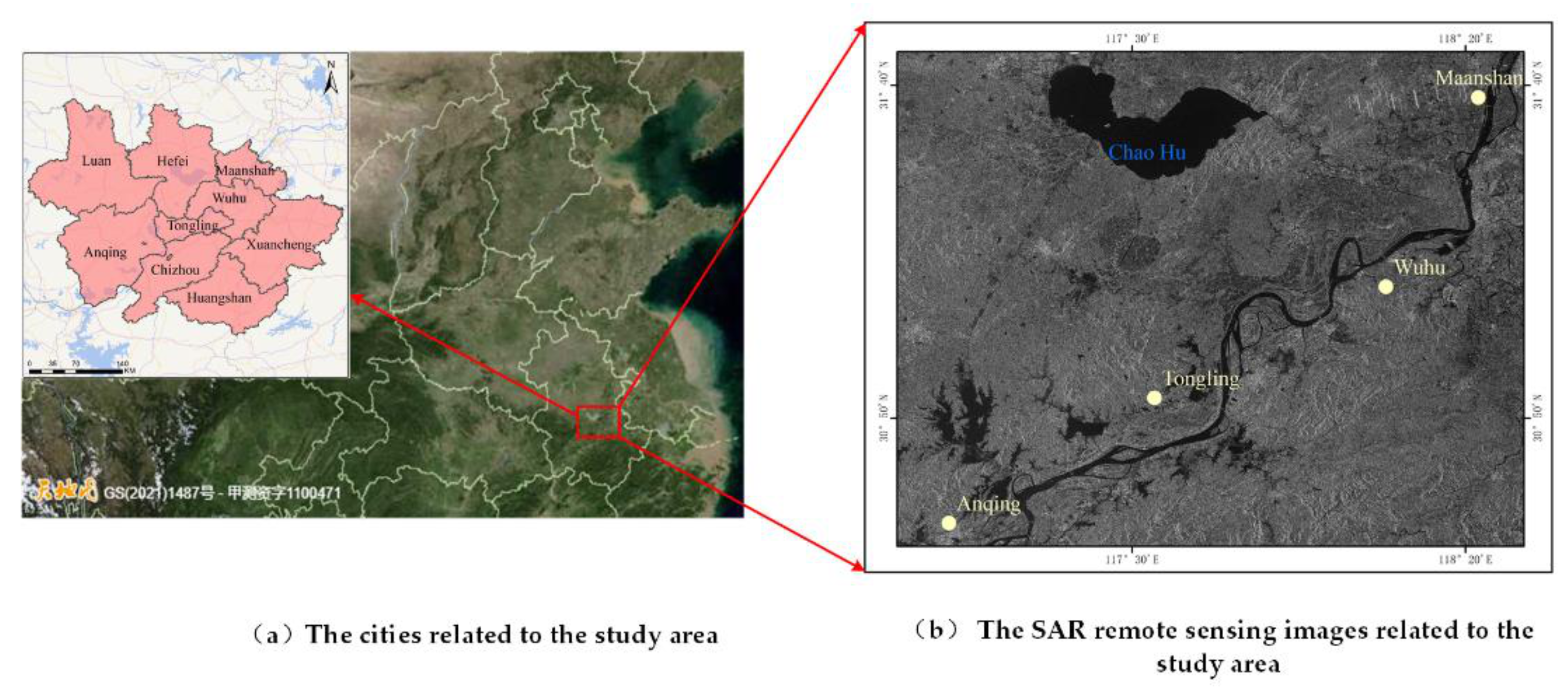
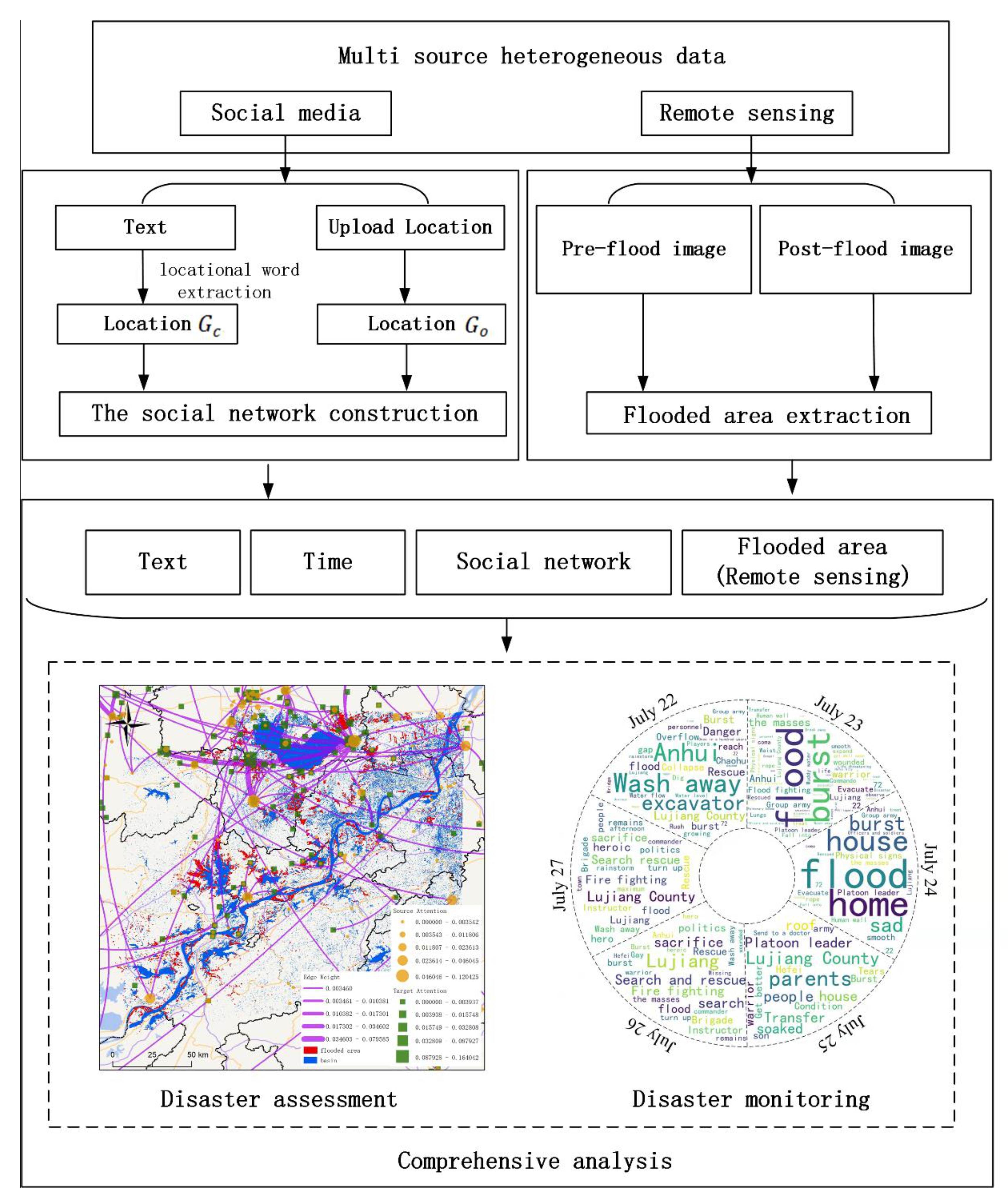


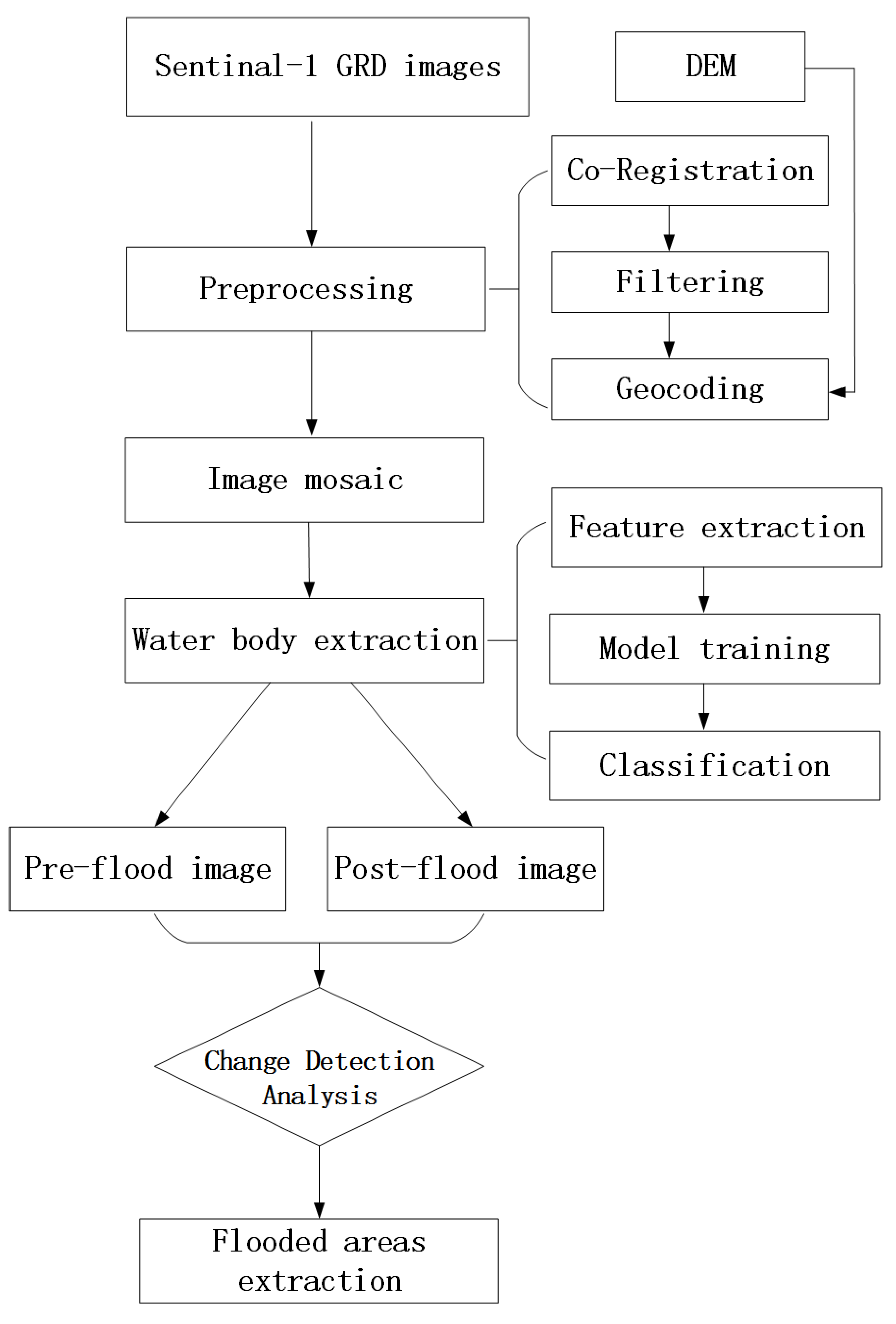
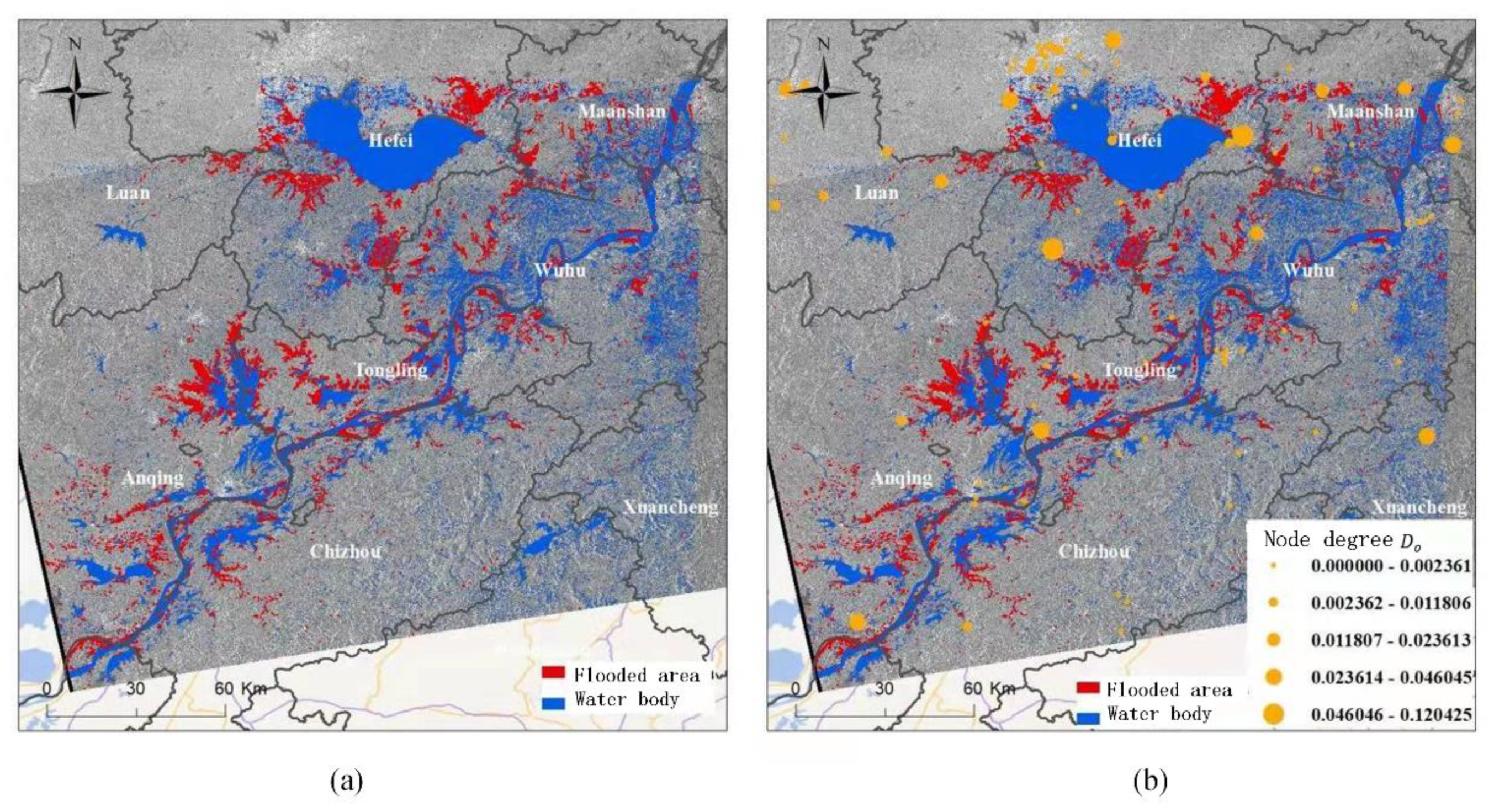
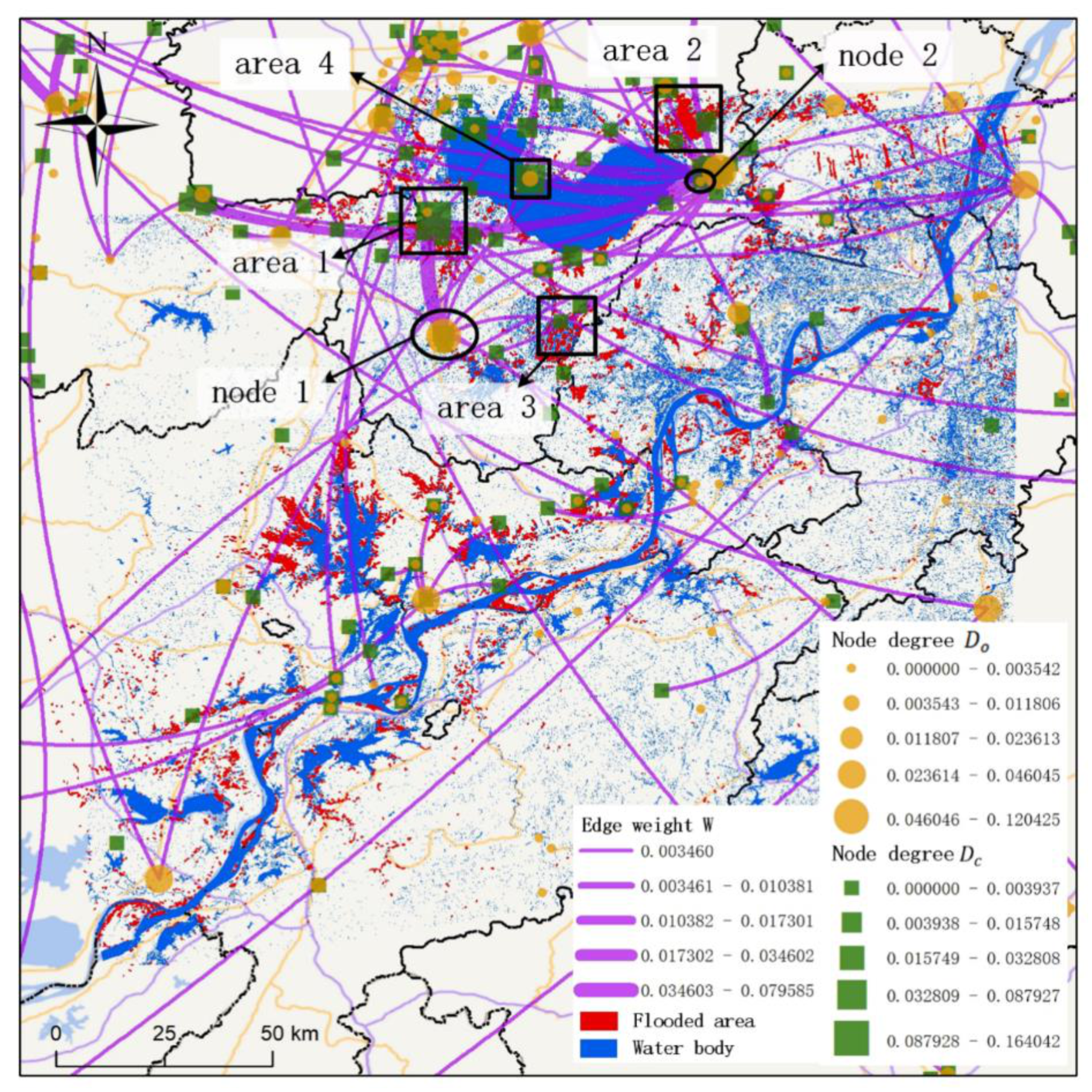
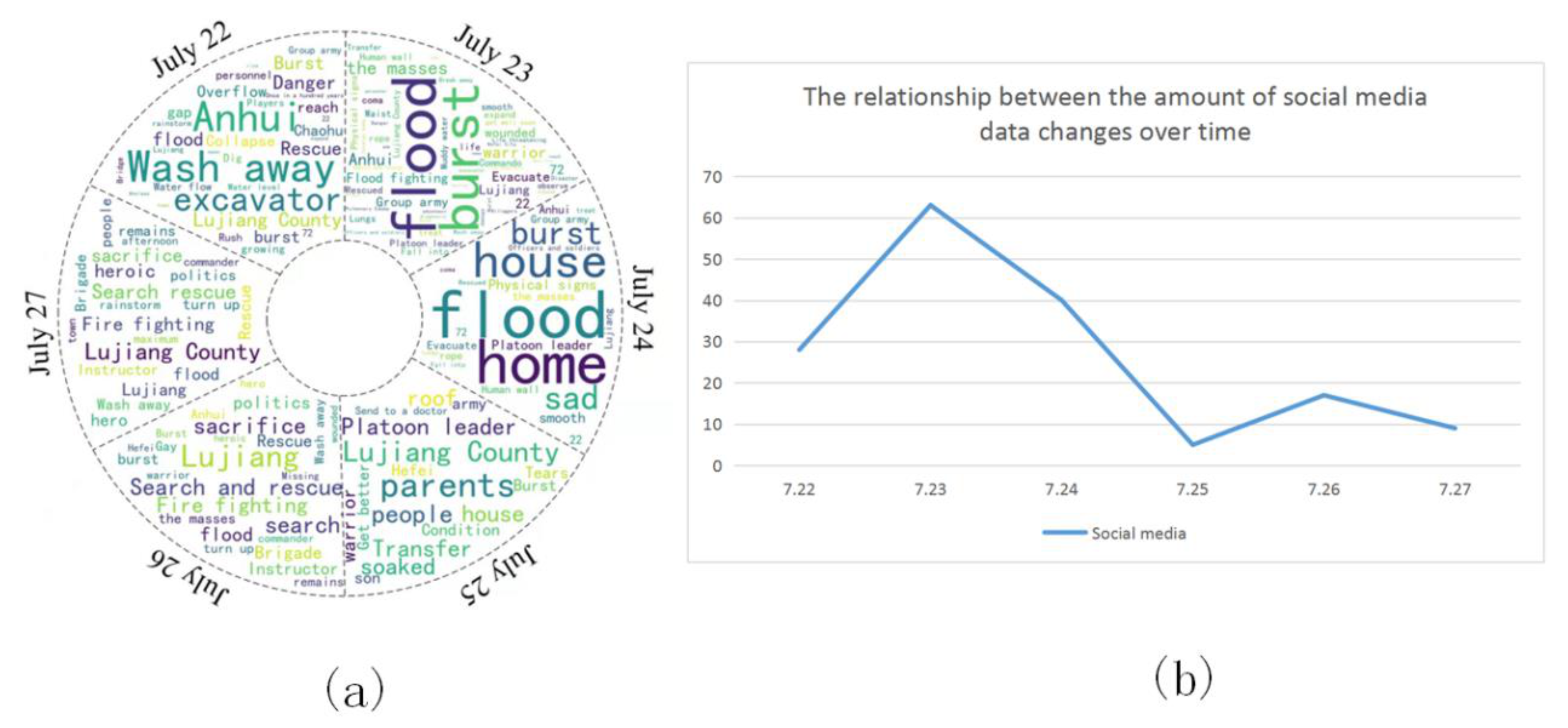
| Microblog | Text | ||
|---|---|---|---|
| 拥有700多年历史的中庙寺被大水淹了。(the Zhongmiao Temple with a history of more than 700 years was flooded by floods) | 石头镇 (Shitou Town) | 中庙寺 (Zhongmiao Temple) | |
| 据说同大镇水淹严重。(it is said that Tongda Town is seriously flooded) | 石头镇 (Shitou Town) | 同大镇 (Tongda Town) | |
| 十字镇也受灾了。(Shizi town was also affected by the disaster) | 十字镇 (Shizi Town) |
Publisher’s Note: MDPI stays neutral with regard to jurisdictional claims in published maps and institutional affiliations. |
© 2022 by the authors. Licensee MDPI, Basel, Switzerland. This article is an open access article distributed under the terms and conditions of the Creative Commons Attribution (CC BY) license (https://creativecommons.org/licenses/by/4.0/).
Share and Cite
Yang, T.; Xie, J.; Li, G.; Zhang, L.; Mou, N.; Wang, H.; Zhang, X.; Wang, X. Extracting Disaster-Related Location Information through Social Media to Assist Remote Sensing for Disaster Analysis: The Case of the Flood Disaster in the Yangtze River Basin in China in 2020. Remote Sens. 2022, 14, 1199. https://doi.org/10.3390/rs14051199
Yang T, Xie J, Li G, Zhang L, Mou N, Wang H, Zhang X, Wang X. Extracting Disaster-Related Location Information through Social Media to Assist Remote Sensing for Disaster Analysis: The Case of the Flood Disaster in the Yangtze River Basin in China in 2020. Remote Sensing. 2022; 14(5):1199. https://doi.org/10.3390/rs14051199
Chicago/Turabian StyleYang, Tengfei, Jibo Xie, Guoqing Li, Lianchong Zhang, Naixia Mou, Huan Wang, Xiaohan Zhang, and Xiaodong Wang. 2022. "Extracting Disaster-Related Location Information through Social Media to Assist Remote Sensing for Disaster Analysis: The Case of the Flood Disaster in the Yangtze River Basin in China in 2020" Remote Sensing 14, no. 5: 1199. https://doi.org/10.3390/rs14051199
APA StyleYang, T., Xie, J., Li, G., Zhang, L., Mou, N., Wang, H., Zhang, X., & Wang, X. (2022). Extracting Disaster-Related Location Information through Social Media to Assist Remote Sensing for Disaster Analysis: The Case of the Flood Disaster in the Yangtze River Basin in China in 2020. Remote Sensing, 14(5), 1199. https://doi.org/10.3390/rs14051199







